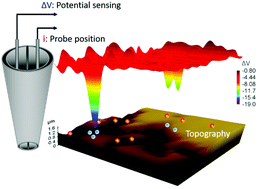Simultaneous mapping of nanoscale topography and surface potential of charged surfaces by scanning ion conductance microscopy†
Abstract
Scanning ion conductance microscopy (SICM) offers the ability to obtain nanoscale resolution images of the membranes of living cells. Here, we show that a dual-barrel nanopipette probe based potentiometric SICM (P-SICM) can simultaneously map the topography and surface potential of soft, rough and heterogeneously charged surfaces under physiological conditions. This technique was validated and tested by systematic studies on model samples, and the finite element method (FEM) based simulations confirmed its surface potential sensing capability. Using the P-SICM method, we compared both the topography and extracellular potential distributions of the membranes of normal (Mela-A) and cancerous (B16) skin cells. We further monitored the structural and electrical changes of the membranes of both types of cells after exposing them to the elevated potassium ion concentration in extracellular solution, known to depolarize and damage the cell. From surface potential imaging, we revealed the dynamic appearance of heterogeneity of the surface potential of the individual cell membrane. This P-SICM method provides new opportunities to study the structural and electrical properties of cell membrane at the nanoscale.



 Please wait while we load your content...
Please wait while we load your content...